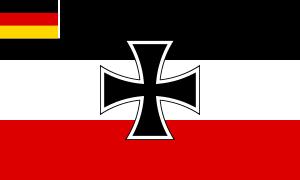The Reichswehr (English: Reich Defence), formed the military organization of Germany from 1919 until 1935, when it was united with the newly founded Wehrmacht ("Defence Force").At the end of World War I, the forces of the German Empire had mostly split up, the men making their way home individually or in small groups. Many of them joined the Freikorps ("Free Corps"), a collection of volunteer paramilitary units that were involved in revolution and border clashes between 1918 and 1923.It was conceded that the newly formed Weimar Republic did need a military, so on 6 March 1919 a decree established the Vorläufige Reichswehr ("Provisional National Defence"), consisting of a Vorläufige Reichsheer ("Provisional National Army") and a Vorläufige Reichsmarine ("Provisional National Navy"). On 30 September 1919, the army was reorganized as the Übergangsheer ("Transitional Army"). About 400,000 men served in the armed forces. This lasted until 1 January 1921, when the Reichswehr was officially established according to the limitations imposed by the Treaty of Versailles (Articles 159 to 213). The Reichswehr was a unified organization composed of the following (as was allowed by the Versailles Treaty):The Reichsheer, an army consisting of two group commands,seven infantry divisions, andthree cavalry divisions.The Reichsmarine, a navy with a limited number of certain types of ships and boats. No submarines were allowed. The Reichswehr was limited to a standing army of 100,000 men, and a navy of 15,000. The establishment of a general staff was prohibited. Heavy weapons such as artillery above the calibre of 105 mm (for naval guns, above 205 mm), armoured vehicles, submarines and capital ships were forbidden, as were aircraft of any kind. Compliance with these restrictions was monitored until 1927 by the Military Inter-Allied Commission of Control.Despite the limitations on its size, their analysis of the loss of World War I, research and development, secret testing abroad (in cooperation with the Red Army) and planning for "better times" went on. As well, although forbidden to have a general staff, the army continued to conduct the typical functions of a general staff under the disguised name of Truppenamt ("Troop Office"). During this time, many of the future leaders of the Wehrmacht — such as Heinz Guderian — first formulated the ideas that they were to use so effectively a few years later.The military refused to accept the democratic Weimar republic as legitimate and instead the Reichswehr under the leadership of Hans von Seeckt became a “state within the state” that operated largely outside of the control of the politicians. Reflecting this position as a “state within the state”, the Reichswehr created the Ministeramt or Office of the Ministerial Affairs in 1928 under Kurt von Schleicher to lobby the politicians. The German historian Eberhard Kolb wrote that:“…from the mid-1920s onwards the Army leaders had developed and propagated new social conceptions of a militarist kind, tending towards a fusion of the military and civilian sectors and ultimately a totalitarian military state (Wehrstaat)”. The biggest influence on the development of the Reichswehr was Hans von Seeckt (1866–1936), who served from 1920 to 1926 as Chef der Heeresleitung (literally "Chief of the Army Command").Whilst the reduction of the peacetime strength of the German army from 780,000 (1913) to 100,000 actually enhanced the quality of the Reichsheer (only the best would be permitted to join the army) the changing face of warfare meant that the smaller army was largely helpless without mechanised and aerial support, no matter how much effort was put into modernising infantry tactics.In 1933 and 1934 after Adolf Hitler became Chancellor of Germany, the Reichswehr began a secret program of expansion. After the Nazi takeover of power, in which the Sturmabteilung ("Storm Battalion"; SA), the Nazi Party militia, played a prominent part, Ernst Röhm and his SA colleagues thought of their force (now over three million strong) as the future army of Germany, replacing the Reichswehr and its professional officers, whom they viewed as "old fogies" who lacked "revolutionary spirit". Röhm wanted to be made Minister of Defense. In February 1934, he demanded that the much smaller Reichswehr be merged into the SA to form a true "people's army". This alarmed both political and military leaders. To forestall the possibility of a coup, Hitler sided with conservative leaders and the military. Röhm and the entire leadership of the SA were killed (along with many other political adversaries of the Nazis) during the Night of the Long Knives. The secret programme of expansion by the military finally became public with the formal announcement of the Wehrmacht in 1935.

Fin de la actividad (año)
1935
Nombre del color
Schwarz-Rot-Gold
Símbolo de identificación
Iron Cross
Papel
Armed forces of the Weimar Republic



Comentar
0